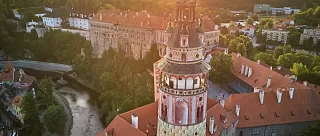Český Krumlov State Castle and Château
Český Krumlov State Castle and Château, the second largest castle and château complex in the Czech Republic, is one of the most important monuments in Central Europe and forms one of the city's main landmarks.
In addition to the castle interiors, which are presented to the public by two sightseeing routes, the complex offers a wide range of other historical delicacies in the form of the castle tower, a symbol of the rich history and artistic beauty of Český Krumlov, the Baroque castle garden from the 17th century and the Baroque theatre.
Basic tour I.
Original historic castle interiors from the Renaissance and Baroque periods. The tour route includes, among other things, the castle chapel of St. George, the Eggenberg Hall with its "golden" carriage and the famous rococo masquerade hall.
Open from 1 April to 31 October
Basic tour II.
The second tour route introduces visitors to the history of the Schwarzenberg family. It begins with a visit to the Schwarzenberg portrait gallery with paintings of the most important members of the family from the 15th to the early 20th century, passes through the original historic interiors from the 1st and 2nd half of the 19th century and ends with a tour of the unique connecting corridors of the shell bridge.
Open from 1 May to 30 September
Baroque Castle Theatre
The Baroque Theatre at Český Krumlov Castle represents the advanced Baroque scene. It is one of the most comprehensively preserved Baroque theatres in the world, with its original theatre building, orchestra pit, stage and machinery, hundreds of theatre costumes and costume accessories, sets and scenic accessories, lighting fixtures, librettos, etc. Thanks to sensitive restoration, the Baroque Theatre has become a unique monument of world importance.
Open from 1 May to 31 October
Castle Museum and Castle Tower
The Castle Museum will take you back to the times of the Lords of Krumlov, the Rožmberks and other important noblemen who lived in Český Krumlov and changed its face over the centuries. There are many valuable exhibits from the castle's depositories. A climb up 162 steps to the observation gallery of the castle tower rewards visitors with a view of the entire town and its surroundings.
Open all year round
Stables and saddlery
The exhibition in the 5th courtyard includes carriages, preserved chaps, halters, smokers, baroque saddles and other parts of equestrian equipment. The most eye-catching artefact is the Schwarzenberg carriage for the coronation of Empress Maria Theresa in Prague, pulled by a ceremoniously dressed six-carriage team. The princely stables were built between 1750 and 1752 to house the half-breeds used by the nobility for rides around the area.
Open in July and August
Baroque Castle Garden
The Baroque garden from the second half of the 17th century is situated on the hill and slope southwest of the castle. It consists of four parts: the terrace of the so-called "Steppe Garden", the terrace of the so-called "Summer Riding Hall" lined with a backdrop of mature lime trees, the Lower parterre with a hint of reconstructed rococo decoration and a cascading fountain, and the Upper Garden with its open garden, music pavilion, rococo Bellarie summerhouse and square castle pond.
Open from 1 April to 31 October
Study Centre
Part of the château complex is the reconstructed building of the Study Centre in the first château courtyard. It offers the possibility of long-term study stays, accommodation, but also facilities for workshops, concerts and other social gatherings.
Points of Interest
- in 1989, the château complex was declared a National Cultural Monument
- in 1992, the entire historic complex was inscribed on the UNESCO World Cultural and Natural Heritage List
- the castle complex is one of the largest in Central Europe
- it comprises forty buildings and palace structures centred around five castle courtyards and seven hectares of castle gardens
- the castle tower, with 162 steps, rises to a height of 86 m above the level of the Vltava River
- in the castle moat, bears have been bred since 1707; currently you can see two female bears named Maria Theresa and Masha and a male called Arn




